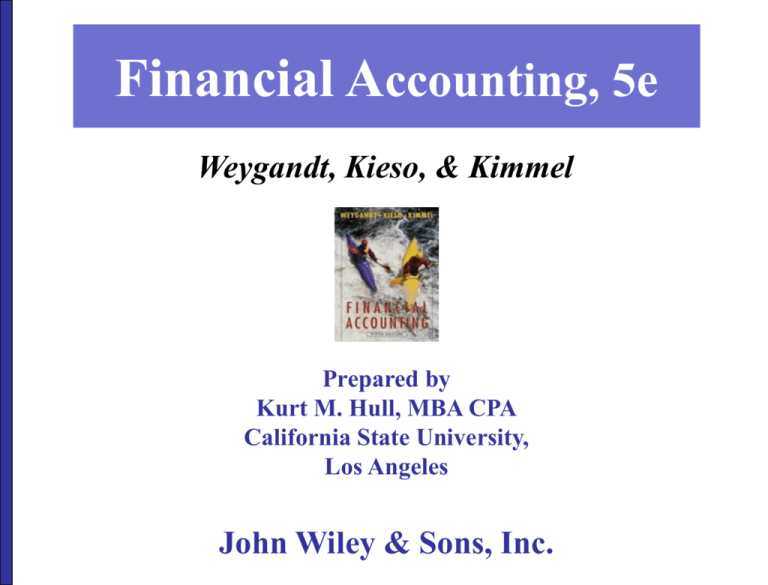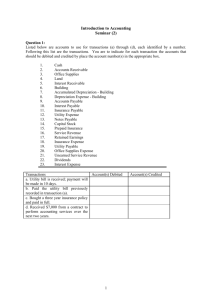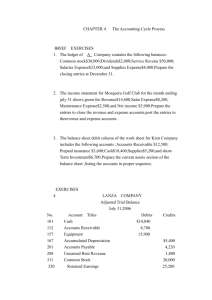
Financial Accounting, 5e
Weygandt, Kieso, & Kimmel
Prepared by
Kurt M. Hull, MBA CPA
California State University,
Los Angeles
John Wiley & Sons, Inc.
CHAPTER 4
COMPLETION OF THE ACCOUNTING CYCLE
STUDY OBJECTIVES
After studying this chapter, you should understand:
How to prepare a
worksheet
The closing process
Steps in the
accounting cycle
Correcting entries
The post-closing trial The classified balance
balance
sheet
STUDY OBJECTIVE 1
PREPARING A WORKSHEET
• A work sheet is a multiple-column form that may be
used in the adjustment process and in preparing
financial statements.
• It is an optional tool --not a permanent record.
• Adjustments are journalized and posted from the
work sheet after financial statements are prepared.
FORM AND PROCEDURE
FOR A WORK SHEET
Work Sheet
Account
Titles
Trial Balance
Dr.
Cr.
Adjustments
Dr.
Cr.
Adjusted
Trial Balance
Dr.
Cr.
Income
Statement
Dr.
Cr.
Balance
Sheet
Dr.
Cr.
(Ledger
account
titles)
(Additional
account titles
for
adjustments)
1.
Prepare a
trial balance
on the
work sheet
2.
Enter
adjustment
dates
3.
Enter
adjusted
balances
4.
Extend adjusted balances to
appropriate statement columns
5.
Total the statement columns,
compute net income (or net
loss), and complete work sheet
STEPS IN PREPARING A WORKSHEET
1 Prepare a trial balance on the worksheet
2 Enter the adjustments in the adjustments columns
3 Enter adjusted balances in the adjusted trial balance columns
4 Extend adjusted trial balance amounts to the F/S columns
5 Total F/S columns, compute net income or loss, and complete
the worksheet
PREPARING A WORKSHEET
STEP 1—PREPARE TRIAL BALANCE
PIONEER ADVERTISING AGENCY
Work Sheet
For the Month Ended October 31, 2006
Account Titles
Cash
Advertising Supplies
Prepaid Insurance
Office Equipment
Notes Payable
Accounts Payable
Unearned Fees
Common Stock
Retained Earnings
Dividends
Service Revenue
Salaries Expense
Rent Expense
Totals
Advertising Expense
Insurance Expense
Accum. Depr.— Office Equip.
Depreciation Expense
Interest Expense
Accounts Receivable
Interest Payable
Salaries Payable
Totals
Trial Balance
Dr.
Cr.
15,200
2,500
600
5,000
5,000
2,500
1,200
10,000
500
10,000
4,000
900
28,700
28,700
Adjustments
Dr.
Cr.
Adjusted
Trial Balance
Dr.
Cr.
PREPARING A WORKSHEET
STEP 2—ENTER ADJUSTMENTS
PIONEER ADVERTISING AGENCY
Work Sheet
For the Month Ended October 31, 2006
Account Titles
Cash
Advertising Supplies
Prepaid Insurance
Office Equipment
Notes Payable
Accounts Payable
Unearned Fees
Common Stock
Retained Earnings
Dividends
Service Revenue
Salaries Expense
Rent Expense
Totals
Advertising Supplies Expense
Insurance Expense
Accum. Depr. — Office Equip.
Depreciation Expense
Interest Expense
Accounts Receivable
Interest Payable
Salaries Payable
Totals
Trial Balance
Adjustments
Dr.
Cr.
Dr.
Cr.
15,200
2,500
a 1500
600
b
50
5,000
5,000
2,500
1,200 d 400
10,000
500
10,000
4,000
900
28,700
g
d
e
400
200
c
40
f
g
50
1200
3,440
1200
28,700
a 1500
b
50
c
f
e
40
50
200
3,440
Adjusted
Trial Balance
Dr.
Cr.
PREPARING A WORKSHEET
STEP 3—ENTER ADJUSTED T/B AMOUNTS
PIONEER ADVERTISING AGENCY
Work Sheet
For the Month Ended October 31, 2006
Account Titles
Cash
Advertising Supplies
Prepaid Insurance
e
Office Equipment
Notes Payable
Accounts Payable
Unearned Fees
Common Stock
Retained Earnings
Dividends
Service Revenue
Salaries Expense
Rent Expense
Totals
Advertising Supplies Expense
Insurance Expense
Accum. Depr. — Office Equip.
Depreciation Expense
Interest Expense
Accounts Receivable
Interest Payable
Salaries Payable
Totals
Trial Balance
Dr.
Cr.
15,200
2,500
600
5,000
5,000
2,500
1,200
10,000
Adjustments
Dr.
Cr.
a 1,500
b 50
d 400
500
10,000
4,000
900
28,700
Adjusted
Trial Balance
Dr.
Cr.
15,200
1,000
550
5,000
5,000
2,500
800
10000
0
500
d 400
e 200
10600
g 1,200
5200
900
a 1,500
b 50
1500
50
28,700
c
40
c 40
f 50
e 200
3,440
40
40
50
200
f 50
g 1,200
3,440
30,190
50
1200
30,190
PREPARING A WORKSHEET
STEP 4—EXTEND TO INCOME STATEMENT COLUMNS
PIONEER ADVERTISING AGENCY
Work Sheet
For the Month Ended October 31, 2006
Account Titles
Cash
Advertising Supplies
Prepaid Insurance
Office Equipment
Notes Payable
Accounts Payable
Unearned Fees
Common Stock
Retained Earnings
Dividends
Fees Earned
Salaries Expense
Rent Expense
Advertising Supplies Expense
Insurance Expense
Accum. Depr. — Office Equip.
Depreciation Expense
Interest Expense
Accounts Receivable
Interest Payable
Salaries Payable
Totals
Net Income
Totals
Adjusted
Trial Balance
Dr.
Cr.
15,200
1,000
550
5,000
5,000
2,500
800
10,000
Income
Statement
Dr.
Cr.
Balance Sheet
Dr.
Cr.
500
10,600
10,600
5,200
900
1,500
50
5,200
900
1,500
50
40
40
50
200
30,190
40
50
50
1,200
30,190
7,740
2,860
10,600
10,600
10,600
22,450
19,590
22,450
2,860
22,450
PREPARING A WORKSHEET
STEP 5—EXTEND TO BALANCE SHEET COLUMNS
PIONEER ADVERTISING AGENCY
Work Sheet
For the Month Ended October 31, 2006
Account Titles
Cash
Advertising Supplies
Prepaid Insurance
Office Equipment
Notes Payable
Accounts Payable
Unearned Fees
Common Stock
Retained Earnings
Dividends
Service Revenue
Salaries Expense
Rent Expense
Advertising Supplies Expense
Insurance Expense
Accum. Depr. — Office Equip.
Depreciation Expense
Interest Expense
Accounts Receivable
Interest Payable
Salaries Payable
Totals
Net Income
Totals
Adjusted
Trial Balance
Dr.
Cr.
15,200
1,000
550
5,000
5,000
2,500
800
10,000
Income
Statement
Dr.
Cr.
500
Balance Sheet
Dr.
Cr.
15,200
1,000
550
5,000
5,000
2,500
800
10000
500
10,600
5,200
900
1,500
50
10,600
5,200
900
1,500
50
40
40
50
200
30,190
40
40
50
200
50
1,200
30,190
7,740
10,600
22,450
50
1200
19,590
2,860
10,600
10,600
22,450
2,860
22,450
JOURNALIZE THE ADJUSTING ENTRIES
GENERAL JOURNAL
Date
2002
Oct. 31
31
31
31
31
31
31
Account Titles and Explanation
a
Advertising Supplies Expense
Advertising Supplies
b
Insurance Expense
Prepaid Insurance
c
Depreciation Expense
Accumulated Expense
d
Unearned Fees
Fees Earned
e
Accounts Receivable
Fees Earned
f
Interest Expense
Interest Payable
g
Salaries Expense
Salaries Payable
Ref.
Debit
Credit
1,500
1,500
50
50
40
40
400
400
200
200
50
50
1,200
1,200
PREPARE INCOME STATEMENT
FROM WORKSHEET BALANCES
PIONEER ADVERTISING AGENCY
Income Statement
For the Month Ended October 31, 2006
Revenues
Service revenue
Expenses
Salaries expense
Advertising supplies expense
Rent expense
Insurance expense
Interest expense
Depreciation expense
Total expenses
Net income
$10,600
The income statement is
prepared from the income
statement columns of the
work sheet.
$5,200
1,500
900
50
50
40
7,740
$ 2,860
PREPARE RETAINED EARNINGS STATEMENT
FROM WORKSHEET BALANCES
PIONEER ADVERTISING AGENCY
Retained Earnings Statement
For the Month Ended October 31, 2006
Retained Earnings, October 1
Add: Net Income
Less: Dividends
Retained Earnings, October 31
The owner’s equity
statement is prepared from
the balance sheet columns
of the work sheet.
0
2860
2860
(500)
2360
PREPARE BALANCE SHEET
FROM WORKSHEET BALANCES
PIONEER ADVERTISING AGENCY
Balance Sheet
October 31, 2006
Liabilities and Stockholders’ Equity
Assets
Cash
Accounts receivable
Advertising supplies
Prepaid insurance
Office equipment
Less: Accumulated
depreciation
Total assets
15,200
200
1,000
550
5,000
40
4,960
21,910
Liabilities
Notes payable
Accou nts payable
Interest payable
Unearned revenue
Salaries payable
Total liabilities
Stockholders’ Equit y
Common Stock
Retained Earnings
Total liabilities and owner’s
equity
The balance sheet is prepared from the
balance sheet columns of the work sheet.
5,000
2,500
50
800
1200
9,550
10,000
2,360
12,360
21,910
THE CLOSING PROCESS
STUDY OBJECTIVE 2
在會計期間結束時,會計人員必須為下一期作準備。此過程稱
為結帳。
Closing entries transfer net income/loss
and dividends to retained earnings.
Journalizing and posting closing entries
is a required step in the accounting cycle
A temporary account, Income Summary,
is used in closing revenue and expense accounts.
TEMPORARY VS. PERMANENT
ACCOUNTS
TEMPORARY (NOMINAL)
These accounts are closed
PERMANENT (REAL)
These accounts are not closed
All revenue accounts
All asset accounts
All expense accounts
All liability accounts
Dividends
Equity accounts
CLOSING PROCESS
CORPORATION
(INDIVIDUAL)
REVENUES
(INDIVIDUAL)
EXPENSES
2
1
INCOME
SUMMARY
1 Debit each revenue account for its balance, and credit
Income Summary for total revenues.
2 Debit Income Summary for total expenses, and credit each
expense account for its balance.
CLOSING PROCESS
CORPORATION
INCOME
SUMMARY
3
RETAINED
EARNINGS
3 Debit (credit) Income Summary and credit (debit)
Retained Earnings for the amount of net income (loss).
CLOSING PROCESS
CORPORATION
RETAINED
EARNINGS
4
DIVIDENDS
4 Debit retained earnings for the balance in the dividends
account and credit dividends for the same amount.
JOURNALIZING
CLOSING ENTRIES
GENERAL JOURNAL
Date
2002
Oct. 1
Date
2002
Oct. 31
Account Titles and Explanation
Ref.
Service Revenue
Income Summary
(To close revenue account)
400
350
INCOME SUMMARY
Explanation
Debit
Credit
10,600
No. 400
Balance
10,600
Date
2002
Oct. 31
Debit
Credit
10,600
10,600
SERVICE REVENUE
Explanation
Debit
10,600
Credit
No. 350
Balance
10,600
–0–
JOURNALIZING
CLOSING ENTRIES
GENERAL JOURNAL
Date
2002
Oct. 31
Account Titles and Explanation
Income Summary
Salaries Expense
Advertising Supplies Expense
Rent Expense
Insurance Expense
Interest Expense
Depreciation Expense
(To close expense
accounts)
Date
2002
Oct. 31
31
INCOME SUMMARY
Explanation
Debit
Credit
10,600
7,740
Ref.
Debit
350 7,740
726
631
729
722
905
911
No. 350
Balance
10,600
2,860
Credit
5,200
1,500
900
50
50
40
JOURNALIZING
CLOSING ENTRIES
GENERAL JOURNAL
Date
2002
Oct. 31
Date
2002
Oct. 31
31
31
Account Titles and Explanation
(3)
Income Summary
Retained Earnings
(To close net income to
retained earnings)
INCOME SUMMARY
Explanation Debit
Credit
10,600
7,740
2,860
No. 350
Balance
10,600
2,860
–0–
Date
2002
Oct. 31
31
Ref.
Debit
350
301
2,860
Credit
2,860
RETAINED EARNINGS
Explanation Debit Credit
10,000
2,860
No. 301
Balance
10,000
12,860
JOURNALIZING
CLOSING ENTRIES
GENERAL JOURNAL
Date
2002
Oct. 31
Date
2002
Oct. 31
31
Account Titles and Explanation
(4)
Retained Earnings
Dividends
(To close dividends to
retained earnings )
Dividends
Explanation Debit
Credit
500
500
No. 350
Balance
500
–0–
Date
2002
Oct. 31
31
Ref.
350
301
Debit
Credit
500
500
Retained Earnings
Explanation
Debit
Credit
2860
500
No. 301
Balance
10,000
2,860
2,360
REVIEW QUESTION
CLOSING ENTRIES
Which of the following accounts will have a zero balance
after the closing process?
1. Unearned Revenue
2. Advertising Supplies
3. Prepaid Insurance
4. Rent Expense
ANSWER
Rent Expense is a temporary account.
All temporary accounts are closed and thus
have a zero balance after the closing process.
POST-CLOSING ENTRIES
AFTER CLOSING ENTRIES ARE POSTED
1. All temporary accounts have zero balances.
2. The balance in retained earnings represents the
accumulated undistributed earnings at the end of the
accounting period.
The income summary account is used only in the
closing process. No entries are journalized or
posted to this account during the year.
The permanent accounts are not closed.
POSTING
CLOSING ENTRIES
Salaries Expense
4,000
(2)
1,200
5,200
726
5,200
5,200
(1)
1
2
Advertising Supplies
Expense
1,500
(2)
Rent Expense
900
(2)
Service Revenue
10,600
10,000
400
200
10,600
10,600
631
1,500
(2)
(3)
729
900
Income Summary
7,740
(1)
10,600
2,860
10,600
350
10,600
3
Insurance Expense
50
(2)
722
50
(4)
2
Retained Earnings
301
500
0
(3)
2,860
2360
Interest Expense
905
50
(2)
50
4
Depreciation Expense
40
(2)
40
711
DIVIDENDS
500
(4)
306
500
400
STUDY OBJECTIVE 3
POST-CLOSING TRIAL BALANCE
• Prepared after all closing entries have been
journalized and posted.
• Purpose is to prove the equality of the
permanent account balances.
POST-CLOSING TRIAL BALANCE
PIONEER ADVERTISING AGENCY
Post -Closing Trial Balance
October 31, 2006
Cash
The post-closing trial
Accounts Receivable
balance is prepared from the
Advertising Supplies
permanent accounts in the
Prepaid Insurance
ledger.
Office Equipment
Accumulated Depreciation — Office Equipment
Notes Payable
Accounts Payable
The post-closing trial balance
Unearned Revenue
provides evidence that the
Salaries Payable
journalizing and posting of
Interest Payable
closing entries has been
Common stock
properly completed.
Retained Earnings
Debit
15,200
200
1,000
550
5,000
21,950
Credit
40
5,000
2,500
800
1,200
50
10000
2,360
21,950
$ 21,950 $ 21,950
STUDY OBJECTIVE 4
STEPS IN THE ACCOUNTING CYCLE
1
2
3
4
5
6
7
8
9
Analyze transactions
Journalize transactions
Post to ledger
Prepare trial balance
Journalize & post adjustments
Prepare adjusted trial balance
Prepare financial statements
Journalize & post closing entries
Prepare post-closing trial balance
STUDY OBJECTIVE 5
CORRECTING ENTRIES
• Errors that occur in
recording transactions
should be corrected as soon
as they are discovered by
preparing correcting entries.
• Correcting entries involve
any combination of balance
sheet and income statement
accounts
CORRECTING ENTRY
May 10
10
20
Incorrect Entry
Cash
Service Revenue
(To record collection from
customer an account)
Correct Entry
Cash
Accounts Receivable
(To record collection from
customer an account)
Correcting Entry
Service Revenue
Accounts Receivable
(To correct entry of May 10)
50
50
50
50
50
50
CORRECTING ENTRY
Incorrect Entry
May 18
Delivery Equipment
Accounts Payable
45
45
(To record purchase of
equipment on account)
Correct Entry
18
Office Equipment
Accounts Payable
450
450
(To record purchase of
equipment on account)
Correcting Entry
June 3
Office Equipment
Delivery Equipment
Accounts Payable
(To correct entry of May 18)
450
45
405
REVIEW QUESTION
CORRECTING ENTRY
Cash of $100 received at the time of service was
rendered and journalized and posted as follows:
Account
Cash
Debit
Credit
$100
Accounts Receivable
$100
Assuming the entry is not reversed,
what is the correcting entry?
Account
Debit
Accounts Receivable
Service Revenue
$100
Credit
$100
STUDY OBJECTIVE 6
CLASSIFIED BALANCE SHEET
A classified balance sheet usually contains the following elements
ASSETS
Current assets
Long-term investments
LIABILITIES &
STOCKHOLDERS EQUITY
Current liabilities
Long-term liabilities
Property, plant & equipment Stockholders’ equity
Intangible assets
CURRENT ASSETS
• Current assets are cash and other resources
expected to be realized in cash, sold, or
consumed within one year of the balance
sheet date or the company’s operating cycle,
whichever is longer.
• Listed on B/S in order of liquidity.
• Examples:
Cash
Accounts Receivable
Inventory
LONG-TERM INVESTMENTS
• Long-term investments are resources that can be
converted to cash.
• Conversion is not expected within one year or the
operating cycle, whichever is longer.
• Examples:
Bond Investments
Long-term receivables
Land held for resale
10 shares
XYZ stock
PROPERTY, PLANT & EQUIPMENT
• Tangible resources of a relatively permanent nature
used in the business and not intended for sale are
classified as property, plant, and equipment.
• Examples: Buildings
Machinery
Equipment
INTANGIBLE ASSETS
• Intangible assets are non-current
resources lacking physical substance.
• Examples:
Patents
Trademarks
Copyrights
CURRENT LIABILITIES
Obligations expected to be
• paid from existing current assets, or
• by creation of another current liability,
within one year/operating cycle, whichever is longer.
Examples:
Accounts Payable
Interest Payable
Wages Payable
LONG-TERM LIABILITIES
Obligations expected to be paid after one year.
Examples:
Long term notes payable
Bonds payable
Mortgages payable
Lease obligations
STOCKHOLDERS’ EQUITY
• The content of the owner’s equity section varies with the
form of business organization.
Proprietorship
Partnership
Partner 1
Capital
Corporation
Partner 2
Capital
Common Stock
Owners Capital
Retained
Earnings
CLASSIFED BALANCE SHEET
PIONEER ADVERTISING AGENCY
Balance Sheet
October 31, 2006
Assets
Current assets
Cash
Accounts receivable
Advertising supplies
Prepaid insurance
Total current assets
Property, plant, and equipment
Office equipment
Less: Accumulated depreciation
Total assets
$ 15,200
200
1,000
550
16,950
$5,000
40
4,960
$21,910
A classified balance sheet helps the financial statement user determine 1 the
availability of assets to meet debts as they come due and 2 the claims of
short- and long-term creditors on total assets.
CLASSIFED BALANCE SHEET
Liabilities and Owner’s Equity
Current liabilities
Notes payable
Accounts payable
Interest payable
Unearned revenue
Salaries payable
Total current liabilities
Long-term liabilities
Notes payable
Total liabilities
Stockholders’ Equity
Common stock
Retained earnings
$1,000
2,500
50
800
1,200
5,550
4,000
9,550
$10,000
2,360
Total stockholders’ equity
Total liabilities and owner’s equity
The balance sheet is most often presented in the report form,
with the assets above liabilities and owner’s equity.
12,360
$21,910
COPYRIGHT
Copyright © 2006 John Wiley & Sons, Inc. All rights reserved. Reproduction or
translation of this work beyond that permitted in Section 117 of the 1976 United
States Copyright Act without the express written consent of the copyright owner is
unlawful. Request for further information should be addressed to the Permissions
Department, John Wiley & Sons, Inc. The purchaser may make back-up copies for
his/her own use only and not for distribution or resale. The Publisher assumes no
responsibility for errors, omissions, or damages, caused by the use of these
programs or from the use of the information contained herein.
CHAPTER 4
COMPLETION OF THE ACCOUNTING CYCLE








